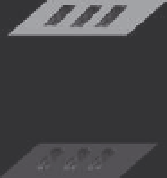Biomedical Engineering Reference
In-Depth Information
Hyaluronan is a biomolecule found in the cartilage extracellular matrix. It is responsible
for tethering a proteoglycan (aggrecan) to the collagen matrix. Studies have shown that it
can guide the differentiation of mesenchymal stem cells to cartilage chondrocytes. In those
experiments, hyaluronan was chemically bound to tissue culture dishes, and undifferenti-
ated cells were added. It was found that a specific molecular size (200,000-400,000 daltons)
was optimal to initiate cartilage formation. Biomolecules such as enzymes, antibodies, anti-
gens, lipids, cell surface receptors, nucleic acids, DNA, antibiotics, and anticancer agents
can all be immobilized on or within polymeric, ceramic, or metal surfaces.
Surface deposition of calcium ions or the use of calcium-containing biomaterials strongly
influences the attachment of bone cells. Hydroxyapatite-coated hip implants show decreased
fibrous tissue formation and increased direct bone bonding. Better bone attachment has also
been found for hydroxyapatite-coated dental implants and spinal fusion cages. Recent studies
have shown that hydroxyapatite ceramics are selective in cell recruitment from the bone
marrow. This may be due to an intermediate step of selective protein adsorption.
The surface modification can be applied in a pattern with a particular feature size, shape,
and periodicity, thus leading to a two-dimensional feature. Patterning techniques will be
discussed in the next section on surface topography and roughness (2-D).
5.5.2 Surface Topography and Roughness (2-D)
Surface topography refers to chemical discontinuities and physical discontinuities on
the surface. Topography and roughness on the surface of a biomaterial have been shown
to provide cues to cells that elicit a large range of cellular responses, including control of
adhesion, cell morphology, apoptosis (cell death), and gene regulation. Modification of
the texture of the biomaterial surface can therefore have dramatic effects on guiding tissue
growth.
Photolithographic techniques can be utilized to micropattern a surface with proteins,
molecules, or functional groups (Figure 5.12). This technique involves using a photoresist
FIGURE 5.12
Photolithography tech-
niques for micropatterning a biomaterial sur-
face with immobilized proteins or functional
molecules involve the use of standard semi-
conductor industry techniques applied to
biomaterials.
Begin with clean biomaterial
surface
Degraded photoresist exposes
biomaterial surface
Photoresist coating
Absorb cell adhesive proteins
Remove photoresist and
culture cells.
Patterned
openings
in mask
Light
Patterned cell
attachment


































